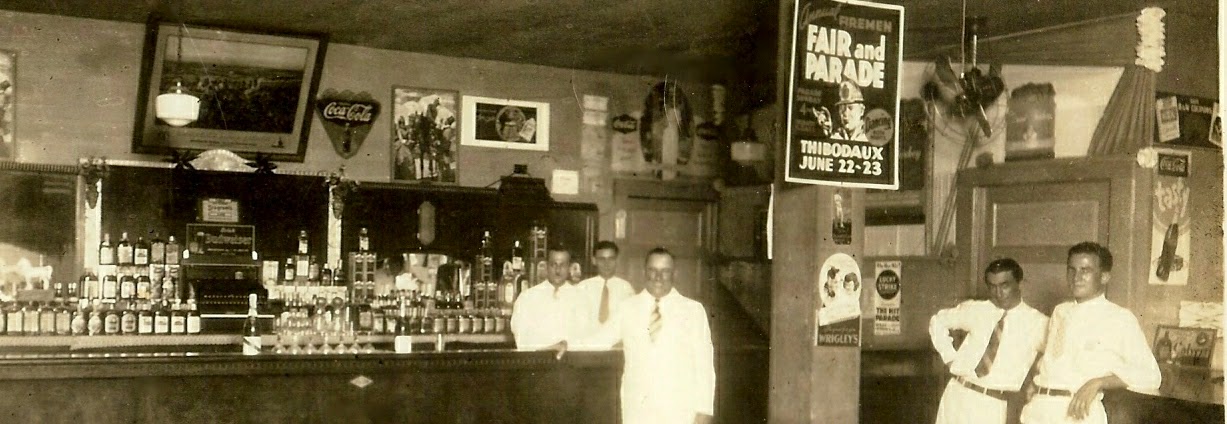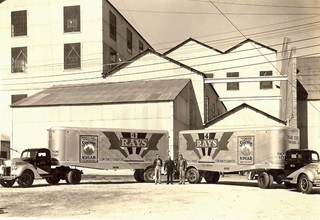Once, mighty paddlewheelers plied the waters of Bayou Lafourche, from its junction with the Mississippi River through Thibodaux, LA, and one to the Gulf of Mexico. When they gave way to wheeled transportation, Louisiana Highway 1 was the main street of the state. Many visitors passed through Thibodaux, LA, during those times. Now, unless you live in the area or happen to be in the oil, gas or agriculture industry, Thibodaux likely isn’t on your itinerary. But if you find yourself passing through, stop for a few minutes to drive through this quaint town.

Thibodaux makes my travel list because my great-grandfather reputedly was a Cajun bootlegger running liquor during Prohibition near Thibodaux, LA.
At least, that’s the story my grandmother liked to hint at when she told a few tales about her family during family holiday visits.

The outline is this: Sometime around or proceeding the Prohibition era, my great-grandfather, Eugene Francois Foret (1888-1963), started a small trucking company near Thibodaux, hauling sugar cane to, then refined sugar to market from, mills around the area. He started with a single truck, grew the business to include more trucks driven by family and friends, and eventually operated a large fleet. His “legitimate” business was named 4-Rays, and it operated out of a large warehouse location near the current site of E. D. White high school in Thibodaux
Sometime in this period, and likely before the onset of the Great Depression, he acquired or built a speakeasy. The large wood building may have been a warehouse before it was transformed for other purposes, as it was part of the trucking company warehouse complex. It featured a large wooden dance floor, live music, and was extremely popular with the local crowds, according to the verbal history.
Whether my great-grandfather and his trucking firm supplied liquor to the speakeasy is a matter of pure speculation. But, suffice it to say that many of the requirements for successful bootlegging were present. A commercially-successful truck fleet, which easily could operate in the open while concealing contraband. A group of loyal drivers comprised primarily of family and friends. And a warehouse complex that included a speakeasy.
My grandmother, Una Foret, (1913-2007) described and once demonstrated one of the popular dances from the speakeasy. It was called the Black Bottom. Similar to the Charleston,the dance could be done by a single dancer or a couple. In my grandmother’s couple version, the male dancer grasped the female by the wrists, then swung her down as she slid between his legs, then back to her feet. Done with full success, the woman would slide gracefully on her feet. However, given the uncertain conditions of many speakeasy dance floors plus the likely effects of whatever bootleg liquor may have been present, most times the woman would drag her rear on the dirty dance floor. Thus, the Black Bottom. A side note: according to Wikipedia, the Black Bottom gained popularity in the New Orleans area after originating with African Americans in the rural South. The dance became nationally popular in the teens and ’20s along with the Charleston.
Sometime after the Depression and perhaps in the early 1940s, the speakeasy became a dance hall and a (legal) bar. At one point in its later history, it was called The Beer Cabin. The main photo on this page is from The Beer Cabin. The man standing in front of the bar at the center of the picture is my great grandfather. Two of my great uncles are pictured to the right.
If You Go:
Wetlands Acadian Culture Center: Part of the Jean Lafitte National Park complex, the Wetlands Acadian Culture Center in Thibodaux offers a visitor center, video focused on Cajun culture and French Canadians who settled the area, walking tours, and boat tours. Cajun music also is featured prominently, including regularly-scheduled live Cajun music jams. (Check the part schedule for details.) If you visit on Tuesday, you may enjoy locals speaking in Cajun French, a regionalized version of the French brought over with the Acadians. My great grandfather’s Foret family was part of the group that originally settled the area after relocating from Nova Scotia.
E.D. White Historic Site: A few miles north of Thibodaux (the locals will explain, “Up the bayou,” as directions were once based on the location relative to Bayou Lafourche, a now-dammed branch of the Mississippi River), the E.D White home is a National Historic Landmark and part of the Louisiana State Museum. The home was built in 1825 for the Edward Douglass White, who served as governor of Louisiana. He lived there with his family, including his son, also Edward Douglass White, who was appointed to the United States Supreme Court in 1894 and served as chief justice from 1910 to 1921.
Nicholls State University. Just “down the bayou,” Nicholls State is part of the University of Louisiana state college system. Each year, it becomes the center of the NFL quarterback universe, hosting the Manning Passing Academy, founded by legendary Saints quarterback Archie Manning and frequented by sons Peyton and Eli as well as many other NFL players and coaches.
Sing a Song: These include references to Thibodaux.
Marcia Ball, Thibodaux, Louisiana. Affectionately referred to as “Her Tallness,” Marcia Ball mixes Texas blues, boogie woogie, Louisiana swamp music and New Orleans beats into her rollicking, piano-pounding party songs. She sings of Thibodaux, “I met a bayou man down there, he said he’d marry me anytime.”
Jimmy Buffett, I Will Play for Gumbo. Parrotheads may remember this from his Beach House on the Moon release. “At midnight in the quarter or noon in Thibodaux, I will play for gumbo.”
Where to Eat:
Spahr’s Seafood Restaurant, 601 W 4th Street. The original location sits on a large fishing pond about 20 miles away in Des Allemands. Try the catfish platter.
Fremin’s Restaurant, 402 W 3rd Street. The exterior will remind you of the French Quarter in New Orleans. The food will remind you that there’s plenty of great local fare in small towns.





